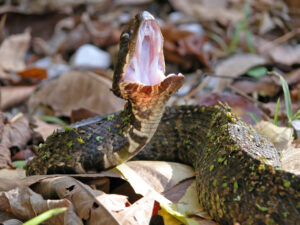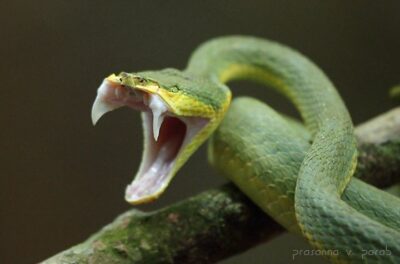While it may be easy to attribute yawning solely to fatigue or boredom in humans, the motivations behind this seemingly simple act in snakes are far more complex and multifaceted. In this article, we delve into the question, “Why do snakes yawn?”
The act of yawning in snakes serves multifaceted purposes, encompassing physiological functions such as enhancing respiratory efficiency, aiding in thermal regulation, and preparing for feeding, while also encompassing behavioral aspects like communication and stress response.
The specific motivation behind a snake’s yawn can vary based on its species, environmental context, and individual circumstances, adding an additional layer of complexity to the fascinating world of these enigmatic reptiles.
Why do snakes yawn?

Snakes don’t yawn in the same way humans do. What might appear as a yawn in a snake is often a behavior associated with stretching or adjusting their jaw rather than a true yawn as seen in mammals. Snakes have a unique jaw structure that allows them to open their mouths wide to swallow large prey whole.
Occasionally, you may observe a snake opening its mouth widely, but this is usually related to jaw adjustments or preparation for feeding.
So, it’s important to note that snakes are cold-blooded, and their behavior is influenced by factors such as temperature, digestion, and environmental conditions. If a snake appears to be stretching or opening its mouth, it could be related to various activities, including regulating body temperature, aligning their jaw after a meal, or simply exploring their surroundings.
If you observe unusual behavior in a pet snake or have concerns about wild snakes, it’s advisable to consult with a veterinarian or a local wildlife expert to ensure the well-being of the snake and to address any potential issues.
Reasons for Snake Yawning
While snakes don’t yawn in the same way mammals do, they do exhibit certain behaviors that might resemble yawning. Here are some reasons why snakes may open their mouths wide, which could be mistakenly interpreted as yawning:
- Thermoregulation: Snakes are ectothermic, meaning they rely on external heat sources to regulate their body temperature. Opening their mouths wide can help them dissipate excess heat, especially when they are basking in the sun. This behavior is a form of thermoregulation and not a true yawn.
- Respiration: Snakes lack a diaphragm, so they rely on body movements to assist with respiration. Opening their mouths wide can help them take in more air and facilitate breathing, especially after engaging in physical activity or during periods of increased metabolic demand.
- Stretching and Realignment: Snakes may open their mouths to stretch and realign their jaws after consuming a large meal. This is particularly common after eating prey items that are wider than the snake’s head. This behavior helps the snake reposition its jawbones back into their normal alignment.
- Exploration: Snakes use their mouths to explore their environment, much like how humans use their hands. Opening their mouths wide allows them to gather information about their surroundings by “tasting” the air with their forked tongues.
It’s essential to understand that these behaviors are not true yawns in the sense that mammals yawn. If you observe a snake exhibiting such behavior and you’re uncertain about its well-being, it’s recommended to consult with a reptile veterinarian or an expert in snake behavior to ensure the snake’s health and address any concerns.
How yawning may help in regulating snake body temperature
In snakes, what appears to be yawning is more accurately described as “mouth gaping,” and it plays a role in regulating their body temperature through a process called thermal exchange. Snakes are ectothermic, meaning they rely on external heat sources to regulate their internal body temperature. Here’s how mouth gaping contributes to this process:
- Heat absorption: When a snake opens its mouth wide, it exposes a large surface area of the oral cavity to the surrounding environment. This allows the snake to absorb heat from the external environment, particularly when basking in sunlight. The heat is then transferred to the snake’s body, helping to elevate its internal temperature.
- Heat dissipation: Conversely, if a snake is too warm, it may engage in mouth gaping to release excess heat. By opening its mouth, the snake increases the surface area for heat dissipation, facilitating the cooling of its body. This is especially important for snakes that have just consumed a meal or engaged in strenuous activities.
- Respiratory function: Mouth gaping also serves a respiratory purpose. Snakes do not have a diaphragm to aid in breathing, and their respiratory system relies on movements of the ribcage and other body structures. Opening the mouth wide allows for increased airflow, aiding in respiration, which can be especially beneficial during activities that demand higher oxygen intake.
Impact of environmental factors on snake yawning

Snake yawning is a behavior observed in many snake species, and while it might appear similar to mammalian yawning, the reasons behind it and its physiological functions can vary. Environmental factors can indeed play a role in snake behavior, including yawning.
Here are some factors that might influence snake yawning:
- Temperature Regulation: Snakes are ectothermic, meaning they rely on external sources to regulate their body temperature. Yawning may be a way for snakes to adjust their jaw muscles, potentially aiding in heat dissipation. By opening their mouths wide, they may facilitate air circulation, which could help regulate their body temperature.
- Respiration: Yawning in snakes could be related to respiration. Snakes have a single lung, and they rely on coordinated movements of their body to breathe effectively. Yawning might help them take in more air and facilitate oxygen exchange, especially after a period of inactivity or during times of increased metabolic demand.
- Digestive Processes: Yawning might also be linked to the digestive processes in snakes. Snakes often swallow prey whole, and the act of yawning could help them reposition their jaws or stretch their esophagus, aiding in the digestion of a recent meal.
- Behavioral Responses: Environmental changes, such as the presence of potential threats or changes in the surroundings, can also trigger snake behaviors, including yawning. It might serve as a defensive mechanism or a way for the snake to prepare for a potential encounter.
- Social Interactions: In some cases, yawning could be a part of social interactions among snakes. It might be a communication signal between individuals or play a role in establishing dominance or resolving conflicts.
Understanding the specific reasons behind snake yawning can be challenging, as it may vary among different species and in different contexts. Additionally, research on snake behavior is an ongoing field, and new discoveries may contribute to a more comprehensive understanding of these behaviors and their underlying mechanisms.
How pet owners can interpret and respond to snake yawning
Interpreting snake behavior, including yawning, requires careful observation and an understanding of the species and individual characteristics. While snake yawning can have various possible explanations, here are some general guidelines for pet owners:
- Consider the Environment:
- Check the temperature and humidity levels in the snake’s enclosure. Ensure that they are within the appropriate range for the species.
- Yawning can be a response to temperature regulation, so observe if the snake is exhibiting other behaviors associated with thermal adjustments.
- Evaluate Respiratory Health:
- Respiratory issues, such as respiratory infections, can manifest in unusual behaviors, including excessive yawning.
- If you notice any wheezing, labored breathing, or other signs of respiratory distress, consult a veterinarian with experience in reptile care.
- Digestive Processes:
- Yawning might be related to the snake’s digestive processes. If the snake has recently eaten, it may yawn as part of the normal digestive cycle.
- Be mindful of the snake’s feeding schedule and ensure that it is provided with an appropriate diet.
- Observe for Stress or Agitation:
- Yawning could be a response to stress or agitation. Look for other signs of stress, such as frequent hiding, refusal to eat, or defensive postures.
- Evaluate the snake’s enclosure for potential stressors, such as inappropriate substrate, inadequate hiding spots, or disturbances.
- Social Context:
- Consider the social context if you have multiple snakes. Yawning could be a part of social interactions between snakes, indicating communication or establishing dominance.
- If you have multiple snakes housed together, monitor their interactions to ensure there is no aggression or competition for resources.
- Consult with a Reptile Veterinarian:
- If you are unsure about the cause of your snake’s yawning or if you observe any concerning signs, consult with a veterinarian specializing in reptile care.
- Regular veterinary check-ups are essential to monitor the overall health of your snake.
Remember that individual snakes may exhibit different behaviors, and what is normal for one species may not be for another. Pay attention to your snake’s overall behavior, eating habits, and any changes in its environment.
If you notice any abnormalities or have concerns, seeking professional advice from a veterinarian experienced in reptile care is crucial for ensuring the health and well-being of your pet snake.
Conclusion
Are you curious to know the reasons snake yawn, We have the answers on this page titled why do snakes yawn. While the exact reasons for snake yawning remain a subject of ongoing research, it is likely associated with a combination of physiological, respiratory, and behavioral factors, emphasizing the importance of continued exploration for a comprehensive understanding of this intriguing aspect of snake behavior.

